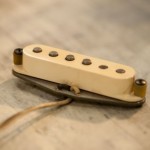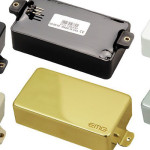Language
Active And Passive Guitar And Bass Pickups Explained
You'll often see a guitar or a bass advertised as having passive or active pickups. What does that mean? The difference matters quite a lot in terms of your instrument's tone and overall output, so here are the basics:
 Best Replacement Pickups For Fender Stratocaster[/caption]
[caption id="attachment_7619" align="alignleft" width="150"]
Best Replacement Pickups For Fender Stratocaster[/caption]
[caption id="attachment_7619" align="alignleft" width="150"] A Closer Look At The Seymour Duncan Antiquity Pickup Lines[/caption]
[caption id="attachment_7620" align="alignleft" width="150"]
A Closer Look At The Seymour Duncan Antiquity Pickup Lines[/caption]
[caption id="attachment_7620" align="alignleft" width="150"] Video: Five Seymour Duncan Neck Pickups Compared[/caption]
Video: Five Seymour Duncan Neck Pickups Compared[/caption]
Passive Guitar And Bass Pickups
Passive pickups are now and have always been the most prevalent type. Indeed, for the first few decades of electric instrument history, they were the only type (pickups are inherently passive). At its simplest, a passive pickup consists of wire wound around a magnet; it converts the vibration of a guitar string into a raw and relatively weak (low output) electric signal, with the harmonic character of the signal depending greatly on the winding. Because they don't require an external power source, passive pickups are highly convenient. They have an "organic" quality that lets them interact more with the amp and with other tone-shaping qualities of the instrument itself. Although a player has limited dynamic control over their sound, passive pickups produce a smooth, even and punchy tone with good mid-range emphasis that is considered highly desirable. Their magnets (pole pieces) are usually visible, and since passive pickups don't require battery power, guitars and basses equipped with them hence do not have onboard battery compartments.Active Guitar And Bass Pickups
Active pickups are a much more recent innovation. The concept kicked around in development for decades before practical use began in earnest in the mid-1970s. Active pickups use additional circuitry to modify the signal, and they require battery power—usually a 9-volt battery housed in a compartment aboard the instrument itself. Active pickups use a preamp that is built into the pickup housing; the idea being to send a more powerful (high-output) signal straight from the instrument into the amp. Unlike passive pickups, the magnets in active pickups are typically concealed. Active pickups produce a louder sound with more bite, more sustain and greater dynamic range and control. They produce less unwanted noise and hum than passive pickups, eliminate the need for a string ground (a wire connecting the strings on most electric guitars to an electrical ground somewhere in the circuit, removing the potential hazard of electric shock), and produce a strong signal relatively unaffected by instrument cord length, amp input characteristics and other tone-shaping qualities of the instrument itself. However, active pickups often cost more than passive pickups, and they will become noticeable quieter when their batteries run down. Active pickups are popular with metal guitarists because they overdrive the input stage of guitar amplifiers more dramatically than lower-output passive pickups and work great with high-gain amps, resulting in a louder, tighter sound (think Metallica's Master of Puppets). Active pickups are especially popular on bass guitars because they deliver a brighter, clearer and snappier sound much better suited to the slap-and-pop playing style.Final Thoughts ...
Well, there you have it. Hopefully, the information above has given you a good grasp on the differences between active and passive pickups along with some of the pros and cons of each.Other Stories You Might Like ...
[caption id="attachment_7618" align="alignleft" width="150"] Best Replacement Pickups For Fender Stratocaster[/caption]
[caption id="attachment_7619" align="alignleft" width="150"]
Best Replacement Pickups For Fender Stratocaster[/caption]
[caption id="attachment_7619" align="alignleft" width="150"] A Closer Look At The Seymour Duncan Antiquity Pickup Lines[/caption]
[caption id="attachment_7620" align="alignleft" width="150"]
A Closer Look At The Seymour Duncan Antiquity Pickup Lines[/caption]
[caption id="attachment_7620" align="alignleft" width="150"] Video: Five Seymour Duncan Neck Pickups Compared[/caption]
Video: Five Seymour Duncan Neck Pickups Compared[/caption]
